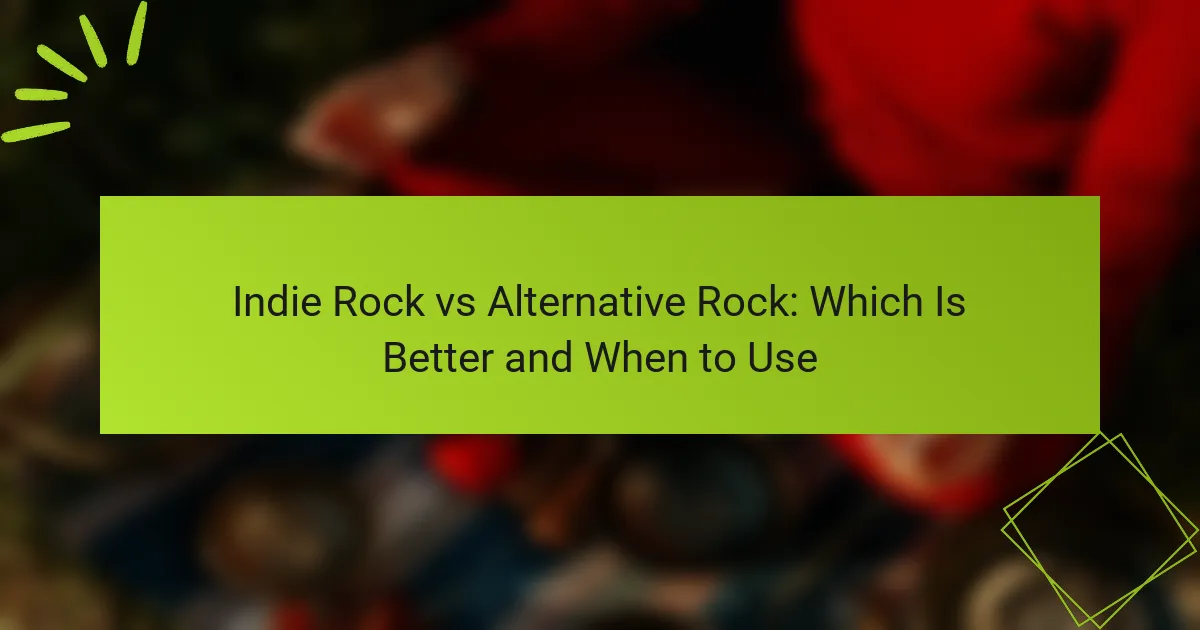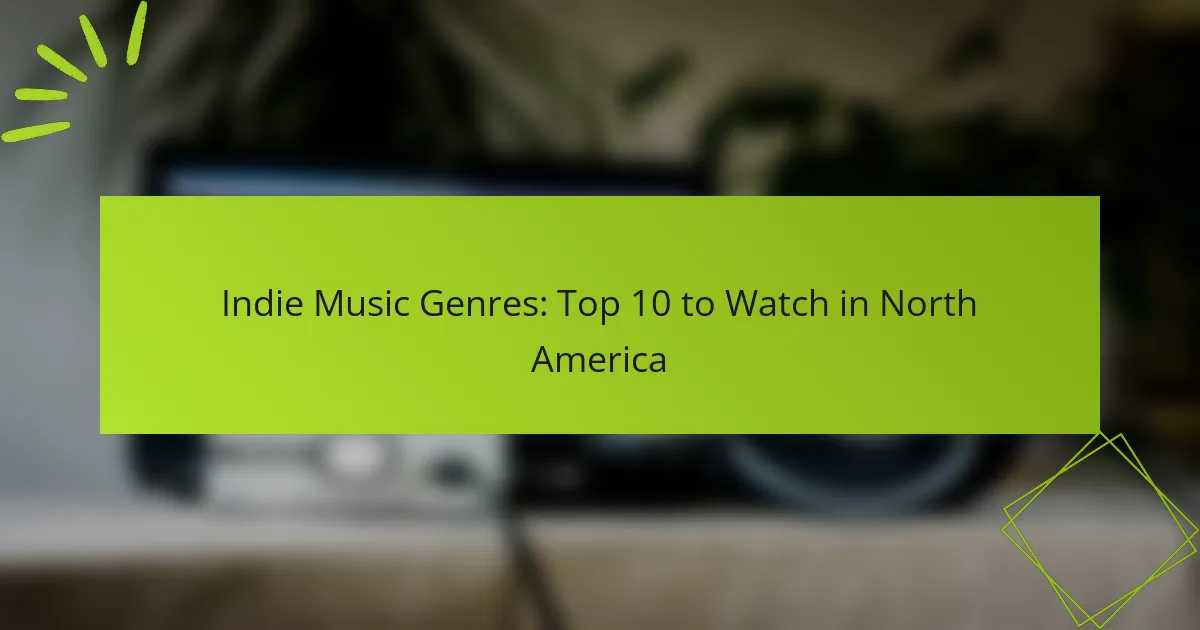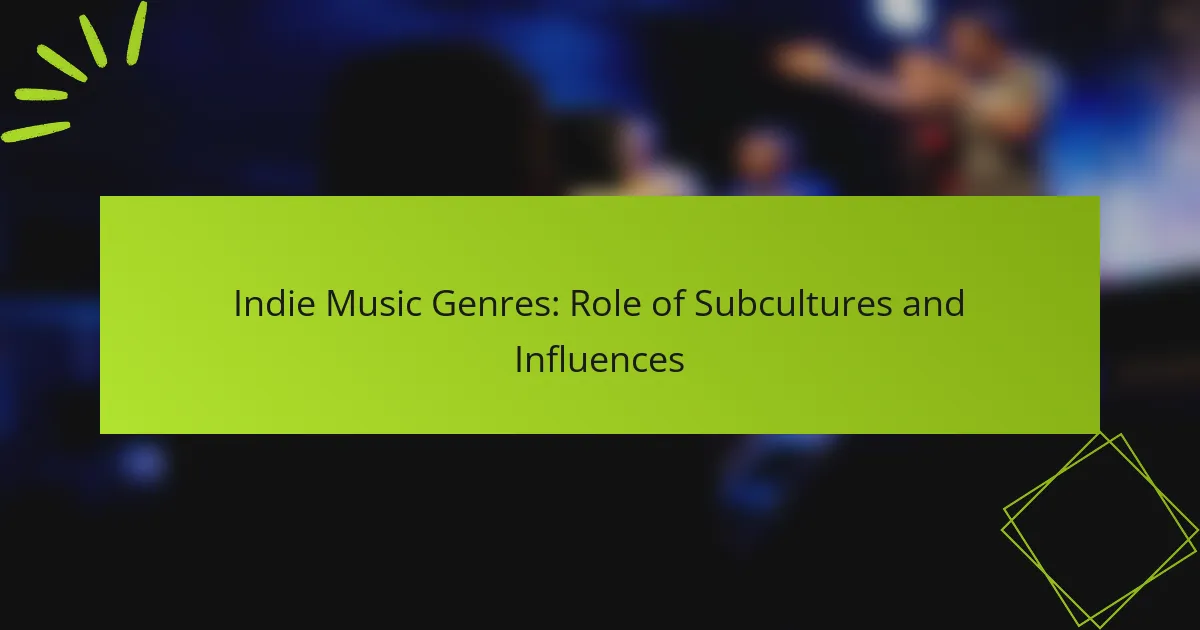Indie Rock and Alternative Rock are two influential genres that, while sharing similarities, are defined by their unique production styles and cultural roots. Indie Rock is characterized by its independent ethos and artistic freedom, making it a great choice for niche audiences, whereas Alternative Rock tends to have a broader appeal and mainstream sound. Understanding the nuances between these genres can help you select the right music for various contexts, whether for personal expression or wider engagement.

What are the key differences between Indie Rock and Alternative Rock?
Indie Rock and Alternative Rock are distinct yet overlapping genres, primarily differentiated by their production styles, themes, and cultural origins. Indie Rock often emphasizes independent production and a DIY ethic, while Alternative Rock typically encompasses a broader range of sounds and mainstream appeal.
Indie Rock characteristics
Indie Rock is characterized by its independent production and a focus on artistic expression over commercial success. Bands often experiment with diverse sounds and unconventional song structures, leading to a more eclectic and personal style.
Thematically, Indie Rock tends to explore introspective and often melancholic subjects, with lyrics that reflect personal experiences and emotions. This genre is also known for its grassroots approach, where artists frequently self-release their music or work with smaller labels.
Alternative Rock characteristics
Alternative Rock emerged as a reaction to mainstream rock, incorporating elements from various genres like punk, new wave, and grunge. It is marked by its diverse sound palette, which can range from melodic and accessible to abrasive and experimental.
Lyrics in Alternative Rock often tackle social and political issues, alongside personal themes. This genre has a wider commercial reach, with many bands achieving significant radio play and chart success, making it more recognizable to the general public.
Historical context of both genres
Indie Rock gained prominence in the 1980s and 1990s, fueled by the rise of independent labels and a growing underground music scene. This movement was a response to the commercialization of music and sought to prioritize artistic integrity.
Alternative Rock, on the other hand, began to gain traction in the late 1980s and early 1990s, with bands like R.E.M. and Nirvana bringing it into the mainstream. This genre’s rise coincided with the popularity of college radio and the emergence of alternative music festivals.
Notable bands in each genre
Some of the most influential Indie Rock bands include The Smiths, Arcade Fire, and Death Cab for Cutie. These groups are known for their unique sound and commitment to independent music production.
In contrast, notable Alternative Rock bands include Radiohead, Pearl Jam, and Foo Fighters. These artists have achieved widespread acclaim and commercial success, often blending elements from various genres while maintaining a distinct alternative sound.

When should you choose Indie Rock over Alternative Rock?
Indie rock is often chosen for its distinct sound and artistic freedom, making it ideal for personal expression and niche audiences. Opt for indie rock when you want to emphasize originality and a DIY ethos, while alternative rock may be better suited for broader appeal and mainstream acceptance.
Best use cases for Indie Rock
Indie rock excels in settings that value creativity and individualism, such as local music festivals, art galleries, and intimate venues. It’s perfect for events where the audience appreciates unique sounds and storytelling, often resonating with younger crowds or those seeking something different from mainstream music.
Consider using indie rock for personal playlists, social gatherings, or creative projects where you want to evoke a sense of authenticity. This genre can enhance the atmosphere in cafes or small bars that cater to a more eclectic clientele.
Situations favoring Alternative Rock
Alternative rock is a strong choice for larger events, such as concerts or festivals, where a diverse audience is present. Its broader appeal makes it suitable for radio play and commercial use, often resonating with listeners who enjoy a mix of rock styles.
Use alternative rock in settings like sporting events, parties, or public gatherings where you want to energize the crowd and create a lively atmosphere. This genre often features catchy hooks and relatable lyrics, making it effective for engaging a wide range of listeners.

How do Indie Rock and Alternative Rock influence digital products?
Indie rock and alternative rock significantly shape the landscape of digital products, particularly in music consumption and marketing strategies. Their distinct characteristics appeal to different audiences, influencing how platforms curate content and how brands engage with consumers.
Impact on music streaming platforms
Music streaming platforms often tailor their offerings based on the unique qualities of indie rock and alternative rock. Indie rock tends to attract niche audiences, prompting platforms to create specialized playlists that highlight emerging artists and underground sounds. In contrast, alternative rock, with its broader appeal, may lead to more mainstream playlists featuring popular tracks.
For example, platforms like Spotify and Apple Music utilize algorithms that analyze listener behavior to recommend indie and alternative tracks. This can result in curated playlists that reflect current trends, helping users discover new music while also promoting lesser-known artists.
Effect on digital marketing strategies
Digital marketing strategies for indie rock and alternative rock often differ due to their target demographics. Indie rock campaigns may focus on authenticity and community engagement, leveraging social media platforms to connect with fans directly. Brands might sponsor local events or collaborate with indie artists to enhance their visibility within this niche market.
On the other hand, alternative rock marketing strategies might employ broader advertising tactics, utilizing mainstream channels like radio and television. Brands often align with popular alternative rock bands to reach a wider audience, using sponsorships and partnerships to enhance brand recognition.
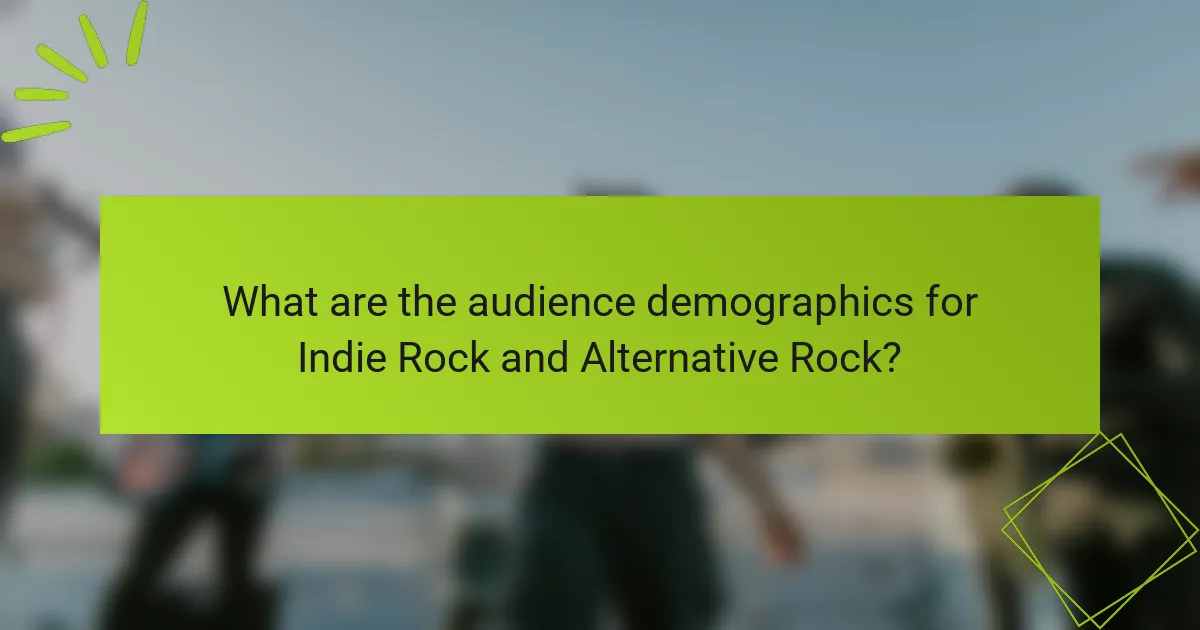
What are the audience demographics for Indie Rock and Alternative Rock?
Indie Rock and Alternative Rock attract distinct audience demographics, each with unique characteristics and preferences. Understanding these profiles can help artists and marketers tailor their strategies effectively.
Indie Rock audience profile
The Indie Rock audience is often characterized by a younger demographic, typically ranging from late teens to early thirties. This group values authenticity and originality, often seeking out lesser-known bands and underground music scenes.
Fans of Indie Rock tend to be more engaged with live performances and local music festivals. They appreciate the DIY ethic and are often active on social media platforms where they discover new artists and share their music experiences.
Alternative Rock audience profile
Alternative Rock appeals to a broader age range, from teenagers to middle-aged listeners, often spanning the 20s to 40s. This audience is generally more mainstream compared to Indie Rock fans, with many drawn to popular bands that have achieved significant radio play and commercial success.
Alternative Rock listeners often enjoy a mix of genres, including pop and punk influences. They may attend larger concerts and festivals, and their music consumption habits include streaming services and curated playlists that feature both classic and contemporary tracks.
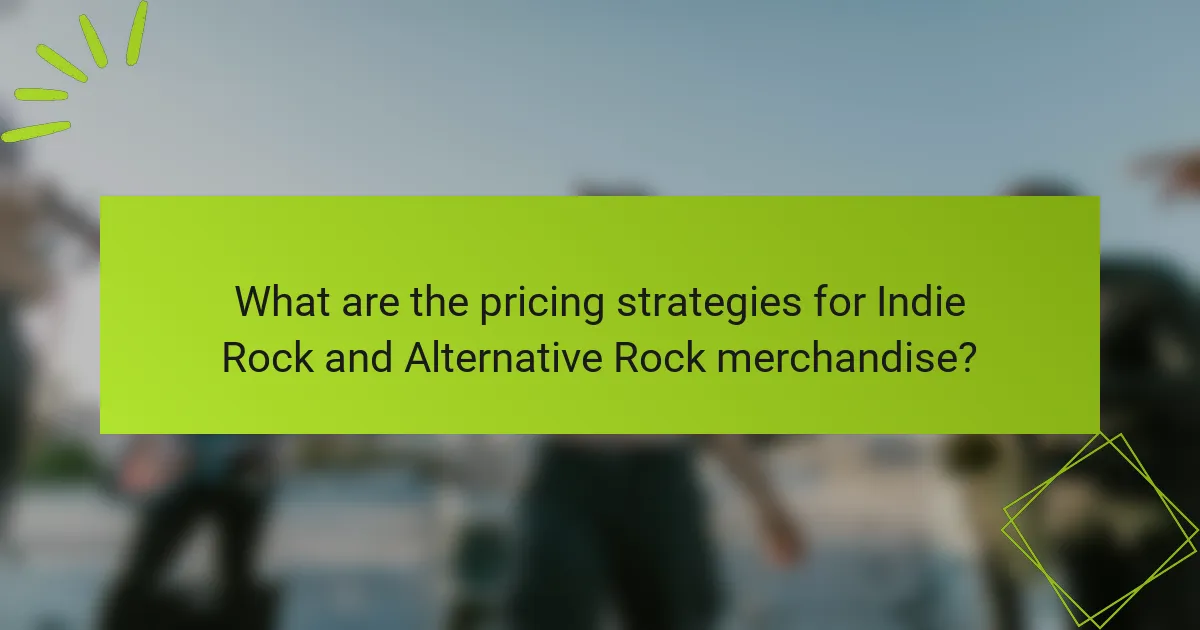
What are the pricing strategies for Indie Rock and Alternative Rock merchandise?
Pricing strategies for Indie Rock and Alternative Rock merchandise often vary based on the target audience, production costs, and brand positioning. Indie Rock merchandise typically focuses on affordability and unique designs, while Alternative Rock merchandise may leverage brand recognition and higher production values to set prices.
Typical price ranges for Indie Rock merchandise
Indie Rock merchandise generally falls within a lower price range to attract a diverse audience. T-shirts, for instance, can cost between $15 to $30, while vinyl records might range from $20 to $40. This pricing strategy allows indie artists to maintain accessibility while promoting their unique style.
When pricing Indie Rock merchandise, consider production costs and the artist’s fan base. Limited edition items or unique designs can command higher prices, but keeping them affordable helps build a loyal following.
Typical price ranges for Alternative Rock merchandise
Alternative Rock merchandise often commands higher prices due to brand recognition and production quality. T-shirts typically range from $25 to $40, while hoodies can go from $40 to $70. This reflects the established fan base and the perceived value of the brand.
When setting prices for Alternative Rock merchandise, it’s essential to balance quality with affordability. Premium items, such as signed memorabilia or exclusive releases, can be priced significantly higher, appealing to dedicated fans willing to invest more.

What emerging trends are shaping the future of Indie Rock and Alternative Rock?
Emerging trends in Indie Rock and Alternative Rock are heavily influenced by technology, cultural shifts, and evolving listener preferences. The rise of digital platforms and social media is transforming how artists connect with audiences and distribute their music.
Influence of social media on music discovery
Social media platforms like Instagram, TikTok, and Twitter are revolutionizing music discovery for Indie and Alternative Rock. Artists can share snippets of their work, engage with fans directly, and create viral moments that lead to increased visibility.
For example, a catchy song clip can gain traction on TikTok, leading to millions of streams on platforms like Spotify or Apple Music. This trend highlights the importance of an active online presence for emerging artists, as it can significantly impact their reach and success.
To leverage social media effectively, artists should focus on consistent content creation and audience engagement. Posting behind-the-scenes content, live performances, and personal stories can foster a loyal fanbase and enhance music discovery.
